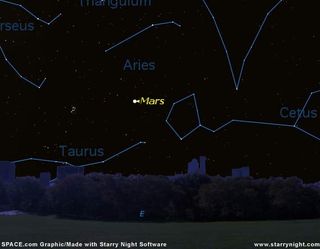
This weekend Mars will make its closest approach to Earth until June 2018. While the event won't make Mars seem any bigger or brighter than the night before or after, it is among the best chances in a lifetime to view the planet.
After brilliant Venus sets, Mars is the brightest "star" in the evening sky [map]. It comes up around a quarter-hour after sunset, but give it at least two more hours to climb above the poor seeing near the horizon. By then it will be at an altitude of around 20 degrees as seen from mid-northern latitudes.
Your clinched fist held at arm's length is roughly equal to 10 degrees, so two hours after it rises, Mars will be about "two-fists" up from the east-northeast horizon.
Stay up late!
Mars appears much sharper and steadier when it crosses the southern meridian, soon after local midnight. Its altitude is then about 66 degrees (more than "six fists" up from the southern horizon).
Mars comes closest to the Earth Saturday night (around 11:25 p.m. Eastern daylight time). The planet is then 43,137,071 miles (69,422,386 kilometers) from Earth, measured center to center. It is at opposition nine days later, on Nov. 7.
The red planet, usually appearing more orange to us, gleams at magnitude -2.3 and through Nov. 29 will rank as the second brightest planet, outshining even Jupiter. (On this astronomers scale, smaller numbers represent brighter objects; negative numbers are reserved for the brightest.)
Get the Space.com Newsletter
Breaking space news, the latest updates on rocket launches, skywatching events and more!
Dust off your telescope
Anyone who has a telescope, no matter how modest it may be, will surely want to see what it can do with Mars. Telescopic observers everywhere will be spying out Mars' bright polar areas, dark surface markings, white clouds and yellow dust storms.
On the night of Mars' closest approach, a telescope magnifying 90 power will make the planet seem to be the same angular size, as the full Moon would appear with the unaided eye. Seeing the largest dark markings should be fairly easy, but finer details are notoriously difficult.
During November Mars departs Earth's vicinity as rapidly as it arrived.
But wait, there's more ...
Between Nov. 7 and Nov. 30, it loses nearly half its brightness, diminishing from magnitude -2.3 to -1.6.
But at the same time, Mars will be very well placed for convenient viewing. Unlike earlier in the fall, you won't have to get up in the early morning hours to see it high in the sky. Mars will be due south at around midnight near the time of its opposition, and around 9:45 p.m. local standard time at the end of November.
On Nov. 14, Mars will be situated below and to the left of the Moon, just one night before it turns full.
- Mars: A History of False Impressions
- Mars Madness: Viewer's Guide and Multimedia
- Mars Hoax Circulates the Internet
Joe Rao serves as an instructor and guest lecturer at New York's Hayden Planetarium. He writes about astronomy for The New York Times and other publications, and he is also an on-camera meteorologist for News 12 Westchester, New York.
| DEFINITIONS |
Magnitude is the standard by which astronomers measure the apparent brightness of objects that appear in the sky. The lower the number, the brighter the object. The brightest stars in the sky are categorized as zero or first magnitude. Negative magnitudes are reserved for the most brilliant objects: the brightest star is Sirius (-1.4); the full Moon is -12.7; the Sun is -26.7. The faintest stars visible under dark skies are around +6. Degrees measure apparent sizes of objects or distances in the sky, as seen from our vantage point. The Moon is one-half degree in width. The width of your fist held at arm's length is about 10 degrees. The distance from the horizon to the overhead point (called the zenith) is equal to 90 degrees. |
Join our Space Forums to keep talking space on the latest missions, night sky and more! And if you have a news tip, correction or comment, let us know at: community@space.com.

Joe Rao is Space.com's skywatching columnist, as well as a veteran meteorologist and eclipse chaser who also serves as an instructor and guest lecturer at New York's Hayden Planetarium. He writes about astronomy for Natural History magazine, the Farmers' Almanac and other publications. Joe is an 8-time Emmy-nominated meteorologist who served the Putnam Valley region of New York for over 21 years. You can find him on Twitter and YouTube tracking lunar and solar eclipses, meteor showers and more. To find out Joe's latest project, visit him on Twitter.
